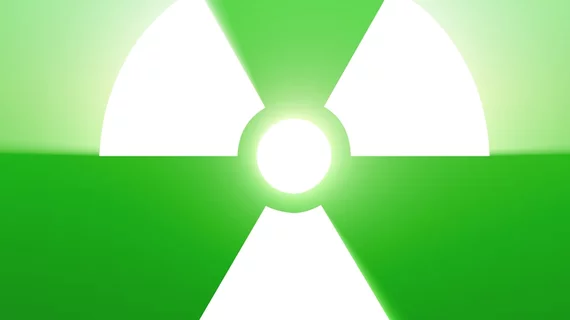Children undergoing chest CT are probably better off with no lead apron shielding the abdomen and pelvis. So concluded researchers at the Mayo Clinic, who tested the shielding on a phantom and found the reduction in radiation dose negligible while the risks of artifacts, infection and patient discomfort remain constant and considerable.
Lifeng Yu, PhD, Cynthia McCollough, PhD, and colleagues quantified dose reduction by measuring dosage overall and in the space between the apron’s edge and the bottom of the scan range. The American Journal of Roentgenology published their findings Nov. 13.
Using a phantom constructed to replicate the head, chest, abdomen and pelvis of a 5-year-old, the team measured dose at points within and outside the scan range during a scan performed on a dual-source CT unit.
They found the weighted-average dose within and outside the scan range was 1.7 and 0.067 mGy, respectively.
The mean dose reduction outside the scan range as achieved by use of the lead apron was just 4.3 percent when the apron was placed 10 centimeters from the bottom of the scan range. Further, at distances of one, five and 10 centimeters from the apron’s edge, corresponding total percentage dose reduction was only 0.7 percent, 0.4 percent and 0.2 percent.
In their discussion, the authors note that the issue of discomfort alone is formidable, not least because it’s common for pediatric patients to move lead aprons out of place and/or into the field of interest, necessitating re-scans. Meanwhile it’s well established that infection risk is real and infection control is time-consuming when imagers work with lead aprons.
“Although it is always appropriate to consider reducing radiation dose to the patient as much as possible, following the principle of ALARA (as low as reasonably achievable), consideration of the aforementioned risks and the additional effort required to position and clean the aprons for each patient, as well as the extremely small amount of dose reduction resulting from use of the apron, we do not recommend the use of lead aprons during CT to shield anatomy outside the scan range,” the authors wrote.
At the same time, they urge imaging center leaders and staff to formulate clear policies, and follow them consistently, to ensure safe and proper use of lead aprons in pediatric CT.
“It may be arguable that when anesthesia is used during imaging studies of children, the lead shield can be positioned nearer to the scan field because patient motion is no longer a significant concern,” the authors added. “However, with the development of faster and faster CT techniques, most of the scans can be performed in a very short period (typically within 1 second), which makes the common practice of using anesthesia during pediatric CT studies obsolete unless it is absolutely necessary.”

